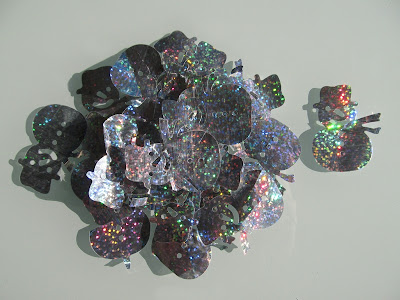Bokeh, Beautiful Bokeh
The term bokeh refers to the out-of-focus regions of a photograph. The shallow depth of field inherent to closeups makes bokeh unavoidable, but to be honest, no one wants to avoid bokeh because it's artistic, beautiful and helps to enhance your subject.
There are two kinds of bokeh; familiar and specular.
Familiar bokeh are background objects which are mildly to severely blurry. In the photo below, There are four pom poms; one is in focus (the subject) and three are out of focus (the familiar bokeh).
Specular bokeh are the sparkling dots of bejeweled light which sometimes appear in the background.
When people think of bokeh, this is the effect which comes to mind most often.
There are two ways by which specular bokeh is created:
There are two ways by which specular bokeh is created:
1 - By light reflecting off high or shiny points on the background, or
2 - By light streaming through small apertures in the background.
In the photo below, our bear is in-focus (the subject), and he is surrounded by colorful, dazzling spots of light which are out-of-focus (the specular bokeh).
Q: How did I create this bejeweled bokeh?
A: Quite easily
I scattered a pile of glitter snowmen on a table by a window with direct sunlight.

Then, I placed my bear in front of the pile and took a closeup in macro mode. The shallow depth of field caused the reflective specks of glitter to become out of focus bejeweled bokeh.
The photo above is a typical result from a compact camera. If you wish to modify the bokeh, you can increase or decrease the distance between the subject and background for subtle changes to the appearance of the bokeh.
But if you'd like your compact to have powerful bokeh enhancement like a DSLR, you can add the Little BigShot lens (LBS) to your camera.
LBS allows a compact to zoom at close range and still achieve a good focus. The more you zoom, the larger the bokeh jewels.
The photos below were taken at 2x, and 2.5x zoom. You can see that as zoom increases, the size of the bokeh jewels also increases.
In these next two images, I increased zoom to 3.5x to create those large, overlapping colored bokeh jewels.
The ability to manipulate bokeh effect by adjusting the zoom adds versatility and artistry to your closeup photography.
You won't always want high magnification for your bokeh. Sometimes, low or no zoom produces the prettiest result.
In this photo, the zoom level is low but the image is festive and stunning.
The next segment will cover the other way to create specular bokeh; with light streaming through small apertures in the background. Check back in a few days!
Like my blog? Like my Facebook Fan Page also! Beware . . . I Like Back!
Back to Main Page







